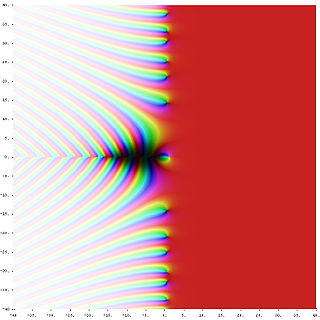In mathematics, the prime number theorem (PNT) describes the asymptotic distribution of the prime numbers among the positive integers. It formalizes the intuitive idea that primes become less common as they become larger by precisely quantifying the rate at which this occurs. The theorem was proved independently by Jacques Hadamard and Charles Jean de la Vallée Poussin in 1896 using ideas introduced by Bernhard Riemann.

The Riemann zeta function or Euler–Riemann zeta function, denoted by the Greek letter ζ (zeta), is a mathematical function of a complex variable defined as
The Riemann hypothesis is one of the most important conjectures in mathematics. It is a statement about the zeros of the Riemann zeta function. Various geometrical and arithmetical objects can be described by so-called global L-functions, which are formally similar to the Riemann zeta-function. One can then ask the same question about the zeros of these L-functions, yielding various generalizations of the Riemann hypothesis. Many mathematicians believe these generalizations of the Riemann hypothesis to be true. The only cases of these conjectures which have been proven occur in the algebraic function field case.

In mathematics, analytic number theory is a branch of number theory that uses methods from mathematical analysis to solve problems about the integers. It is often said to have begun with Peter Gustav Lejeune Dirichlet's 1837 introduction of Dirichlet L-functions to give the first proof of Dirichlet's theorem on arithmetic progressions. It is well known for its results on prime numbers and additive number theory.
In mathematics, a Dirichlet series is any series of the form
In mathematics, a Dirichlet L-series is a function of the form

In mathematics, the Hurwitz zeta function is one of the many zeta functions. It is formally defined for complex variables s with Re(s) > 1 and a ≠ 0, −1, −2, … by

In number theory, the Mertens function is defined for all positive integers n as
In mathematics, the L-functions of number theory are expected to have several characteristic properties, one of which is that they satisfy certain functional equations. There is an elaborate theory of what these equations should be, much of which is still conjectural.
In mathematics, the Selberg trace formula, introduced by Selberg (1956), is an expression for the character of the unitary representation of a Lie group G on the space L2(Γ\G) of square-integrable functions, where Γ is a cofinite discrete group. The character is given by the trace of certain functions on G.
In mathematics, the Dedekind zeta function of an algebraic number field K, generally denoted ζK(s), is a generalization of the Riemann zeta function. It can be defined as a Dirichlet series, it has an Euler product expansion, it satisfies a functional equation, it has an analytic continuation to a meromorphic function on the complex plane C with only a simple pole at s = 1, and its values encode arithmetic data of K. The extended Riemann hypothesis states that if ζK(s) = 0 and 0 < Re(s) < 1, then Re(s) = 1/2.
In mathematics, more specifically in the field of analytic number theory, a Landau–Siegel zero or simply Siegel zero, named after Edmund Landau and Carl Ludwig Siegel, is a type of potential counterexample to the generalized Riemann hypothesis, on the zeros of Dirichlet L-functions associated to quadratic number fields. Roughly speaking, these are possible zeros very near to .
In mathematics, the explicit formulae for L-functions are relations between sums over the complex number zeroes of an L-function and sums over prime powers, introduced by Riemann (1859) for the Riemann zeta function. Such explicit formulae have been applied also to questions on bounding the discriminant of an algebraic number field, and the conductor of a number field.
In mathematics, an Artin L-function is a type of Dirichlet series associated to a linear representation ρ of a Galois group G. These functions were introduced in 1923 by Emil Artin, in connection with his research into class field theory. Their fundamental properties, in particular the Artin conjecture described below, have turned out to be resistant to easy proof. One of the aims of proposed non-abelian class field theory is to incorporate the complex-analytic nature of Artin L-functions into a larger framework, such as is provided by automorphic forms and the Langlands program. So far, only a small part of such a theory has been put on a firm basis.
The Selberg zeta-function was introduced by Atle Selberg (1956). It is analogous to the famous Riemann zeta function
In mathematics, the multiplication theorem is a certain type of identity obeyed by many special functions related to the gamma function. For the explicit case of the gamma function, the identity is a product of values; thus the name. The various relations all stem from the same underlying principle; that is, the relation for one special function can be derived from that for the others, and is simply a manifestation of the same identity in different guises.
In mathematics, the prime zeta function is an analogue of the Riemann zeta function, studied by Glaisher (1891). It is defined as the following infinite series, which converges for :

In mathematics, the Riemann hypothesis is the conjecture that the Riemann zeta function has its zeros only at the negative even integers and complex numbers with real part 1/2. Many consider it to be the most important unsolved problem in pure mathematics. It is of great interest in number theory because it implies results about the distribution of prime numbers. It was proposed by Bernhard Riemann (1859), after whom it is named.

Anatoly Alexeyevich Karatsuba was a Russian mathematician working in the field of analytic number theory, p-adic numbers and Dirichlet series.

In mathematics, Montgomery's pair correlation conjecture is a conjecture made by Hugh Montgomery (1973) that the pair correlation between pairs of zeros of the Riemann zeta function is



































